Deck 21: Taxonomy and Systematics
Question
Question
Question
Question
Question
Question
Question
Question
Question
Question
Question
Question
Question
Question
Question
Question
Question
Question
Question
Question
Question
Question
Question
Question
Question
Question
Question
Question
Question
Question
Question
Question
Question
Question
Question
Question
Question
Question

Unlock Deck
Sign up to unlock the cards in this deck!
Unlock Deck
Unlock Deck
1/38
Play
Full screen (f)
Deck 21: Taxonomy and Systematics
1
Use the principle of parsimony and molecular genetic data to choose a phylogenetic tree for your hypothesis of how the extant species were derived from the ancestor. 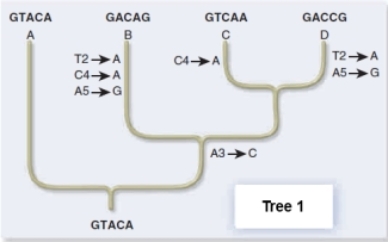

A)Tree 1 requires the most mutations,making it the best choice.
B)Tree 1 requires the fewest mutations,making it the best choice.
C)Tree 2 requires the most mutations,making it the best choice.
D)Tree 2 requires the fewest mutations,making it the best choice.
E)Both trees are equally good because sequences A,B,C,and D are the same in both.


A)Tree 1 requires the most mutations,making it the best choice.
B)Tree 1 requires the fewest mutations,making it the best choice.
C)Tree 2 requires the most mutations,making it the best choice.
D)Tree 2 requires the fewest mutations,making it the best choice.
E)Both trees are equally good because sequences A,B,C,and D are the same in both.
D
2
In the cladogram shown,the animals across the top are a lancelet,lamprey,salmon,lizard,and rabbit (from left to right).If the salmon,lizard,and rabbit are an ingroup,which animals would be an outgroup and which characteristics are necessary to be in the ingroup? 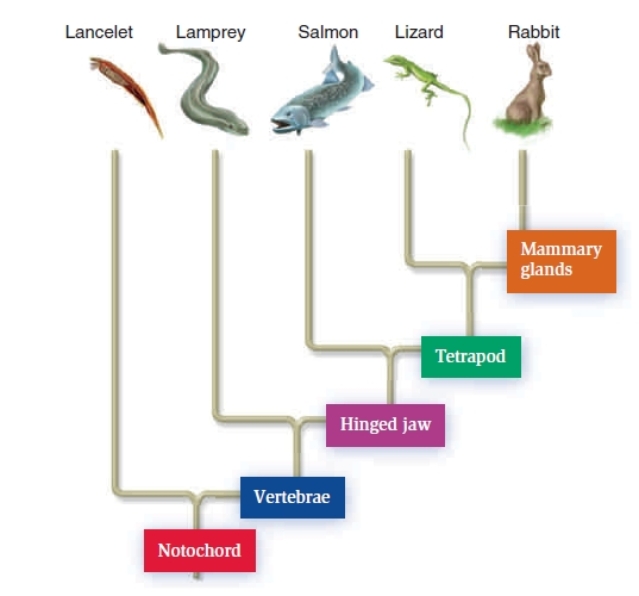
A)Lamprey and lancelet;notochord and vertebrae.
B)Lamprey only;vertebrae,hinged jaw,tetrapod,and mammary glands.
C)Lancelet and lamprey;hinged jaw,tetrapod,and mammary glands.
D)Lancelet,lamprey and salmon;hinged jaw,tetrapod,and mammary glands.
E)Lizard and rabbit;tetrapod and mammary glands.

A)Lamprey and lancelet;notochord and vertebrae.
B)Lamprey only;vertebrae,hinged jaw,tetrapod,and mammary glands.
C)Lancelet and lamprey;hinged jaw,tetrapod,and mammary glands.
D)Lancelet,lamprey and salmon;hinged jaw,tetrapod,and mammary glands.
E)Lizard and rabbit;tetrapod and mammary glands.
C
3
When a species consisting of a single large population slowly evolves over many generations into a new species,this an example of
A)a shared derived character.
B)cladogenesis.
C)anagenesis.
D)monospeciation.
E)horizonal gene transfer.
A)a shared derived character.
B)cladogenesis.
C)anagenesis.
D)monospeciation.
E)horizonal gene transfer.
C
4
Refer to the cladogram below.Which shared derived character is common to the lizard and rabbit but not the salmon? 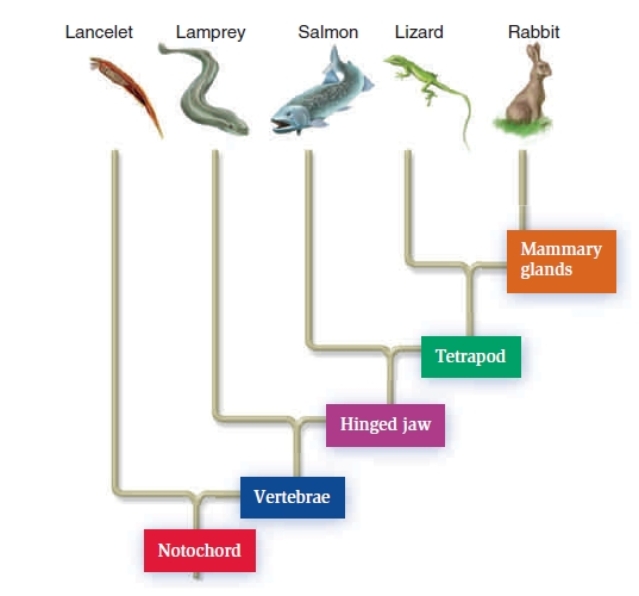
A)Notochord.
B)Vertebrae.
C)Tetrapod locomotion.
D)Mammary glands.

A)Notochord.
B)Vertebrae.
C)Tetrapod locomotion.
D)Mammary glands.

Unlock Deck
Unlock for access to all 38 flashcards in this deck.
Unlock Deck
k this deck
5
Which of the following is NOT a principle used when constructing cladograms?
A)All species or higher taxa are placed on tips in a phylogenetic tree.
B)All species or higher taxa are placed on nodes in a phylogenetic tree.
C)Each cladogram branch point should have one or more shared derived characters that are common to all species above the branch point,unless the character is later modified.
D)All shared derived characters appear together only once in a cladogram unless they arose independently during evolution more than once.
A)All species or higher taxa are placed on tips in a phylogenetic tree.
B)All species or higher taxa are placed on nodes in a phylogenetic tree.
C)Each cladogram branch point should have one or more shared derived characters that are common to all species above the branch point,unless the character is later modified.
D)All shared derived characters appear together only once in a cladogram unless they arose independently during evolution more than once.

Unlock Deck
Unlock for access to all 38 flashcards in this deck.
Unlock Deck
k this deck
6
When choosing among competing cladograms,the preferred hypothesis is the one that is the simplest for all characters and their states.This is also known as
A)the maximum likelihood approach.
B)the principle of parsimony.
C)the Bayesian method.
D)the molecular clock.
E)the cladistic approach.
A)the maximum likelihood approach.
B)the principle of parsimony.
C)the Bayesian method.
D)the molecular clock.
E)the cladistic approach.

Unlock Deck
Unlock for access to all 38 flashcards in this deck.
Unlock Deck
k this deck
7
Linnaeus began naming organisms that were alike using Latin names.He gave each organism two names;for example,the pigmy rattlesnake is called Sistrurus miliarius by scientists.What type of naming system is this and what group does "miliarius" designate?
A)Binomial nomenclature;genus.
B)Binomial nomenclature;species.
C)Polynomial nomenclature;genus.
D)Polynomial nomenclature;species.
A)Binomial nomenclature;genus.
B)Binomial nomenclature;species.
C)Polynomial nomenclature;genus.
D)Polynomial nomenclature;species.

Unlock Deck
Unlock for access to all 38 flashcards in this deck.
Unlock Deck
k this deck
8
Which of the following organisms would NOT be classified in the Domain Eukarya?
A)Canis lupis (wolf).
B)Loxodonta cyclotis (forest elephant).
C)Salmonella enterica (bacteria that causes food poisoning).
D)Aleuria aurantia (ascomycete fungi).
E)Sequoiadendron giganteum (Giant Sequoia tree).
A)Canis lupis (wolf).
B)Loxodonta cyclotis (forest elephant).
C)Salmonella enterica (bacteria that causes food poisoning).
D)Aleuria aurantia (ascomycete fungi).
E)Sequoiadendron giganteum (Giant Sequoia tree).

Unlock Deck
Unlock for access to all 38 flashcards in this deck.
Unlock Deck
k this deck
9
__________ is a term that refers to similarities among various species that occur because the species are derived from a common ancestor.
A)Analogy
B)Phylogeny
C)Homology
D)Heterology
E)Morphology
A)Analogy
B)Phylogeny
C)Homology
D)Heterology
E)Morphology

Unlock Deck
Unlock for access to all 38 flashcards in this deck.
Unlock Deck
k this deck
10
The scientific name for the golden crayfish is Orconectes luteus.Based on this information,the crayfish is a member of what genus?
A)Orconectes luteus.
B)Orconectes.
C)luteus.
D)O.luteus.
E)Orconectes l.
A)Orconectes luteus.
B)Orconectes.
C)luteus.
D)O.luteus.
E)Orconectes l.

Unlock Deck
Unlock for access to all 38 flashcards in this deck.
Unlock Deck
k this deck
11
Can two different species that are members of the same clade have more than one common ancestor? Choose the MOST correct answer and explanation.
A)No.Because they are members of a clade,by definition they can have only one common ancestor.
B)Maybe.Two species in the same clade can have more than one common ancestor only in cases where horizontal gene transfer from a third,previously unrelated,species has occurred.
C)Maybe.If they are members of a clade that is not monophyletic,they can have more than one common ancestor.
D)Yes.Although two species in the same clade have only one most recent common ancestor,they also have a number of older common ancestors that occurred earlier in their evolutionary history.
E)Yes.Two species of the same clade always have eight common ancestors,matching the number of levels higher than species in the taxonomic hierarchy.
A)No.Because they are members of a clade,by definition they can have only one common ancestor.
B)Maybe.Two species in the same clade can have more than one common ancestor only in cases where horizontal gene transfer from a third,previously unrelated,species has occurred.
C)Maybe.If they are members of a clade that is not monophyletic,they can have more than one common ancestor.
D)Yes.Although two species in the same clade have only one most recent common ancestor,they also have a number of older common ancestors that occurred earlier in their evolutionary history.
E)Yes.Two species of the same clade always have eight common ancestors,matching the number of levels higher than species in the taxonomic hierarchy.

Unlock Deck
Unlock for access to all 38 flashcards in this deck.
Unlock Deck
k this deck
12
A phylogenetic tree shows the hypothesized evolutionary relationships among organisms,meaning that its structure can be revised and changed as new information about those relationships becomes known.

Unlock Deck
Unlock for access to all 38 flashcards in this deck.
Unlock Deck
k this deck
13
Of the taxonomic groups listed below,which is the broadest (contains the most species)?
A)Order
B)Class
C)Family
D)Phylum
E)Kingdom
A)Order
B)Class
C)Family
D)Phylum
E)Kingdom

Unlock Deck
Unlock for access to all 38 flashcards in this deck.
Unlock Deck
k this deck
14
The idea that most of the genetic variation found in populations is not subject to natural selection is the basis of:
A)the principle of parsimony
B)the neutral theory of evolution
C)the maximum likelihood approach
D)cladistics
E)systematics
A)the principle of parsimony
B)the neutral theory of evolution
C)the maximum likelihood approach
D)cladistics
E)systematics

Unlock Deck
Unlock for access to all 38 flashcards in this deck.
Unlock Deck
k this deck
15
The science of describing,naming,and classifying extant and extinct organisms is
A)evolution.
B)phylogeny.
C)taxonomy.
D)nomenclature.
E)biology.
A)evolution.
B)phylogeny.
C)taxonomy.
D)nomenclature.
E)biology.

Unlock Deck
Unlock for access to all 38 flashcards in this deck.
Unlock Deck
k this deck
16
This tree is based on which type of traits and what is the genus name for the most recent horse? 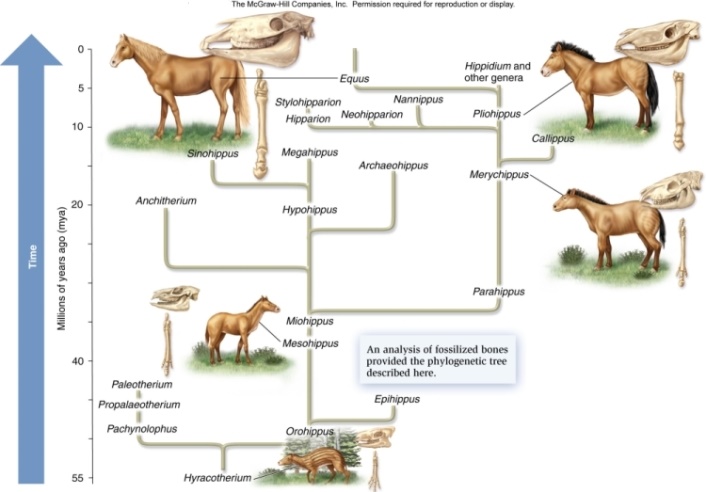
A)Genetic (DNA): Orohippus.
B)Morphological: Equus.
C)Molecular: Equus.
D)Genetic homology: Pliohippus.
E)Morphological: Hyracotherium.

A)Genetic (DNA): Orohippus.
B)Morphological: Equus.
C)Molecular: Equus.
D)Genetic homology: Pliohippus.
E)Morphological: Hyracotherium.

Unlock Deck
Unlock for access to all 38 flashcards in this deck.
Unlock Deck
k this deck
17
The study of biological diversity and evolutionary relationships among organisms is
A)nomenclature.
B)taxonomy.
C)ecology.
D)systematics.
E)biology.
A)nomenclature.
B)taxonomy.
C)ecology.
D)systematics.
E)biology.

Unlock Deck
Unlock for access to all 38 flashcards in this deck.
Unlock Deck
k this deck
18
Which of the following is NOT a domain?
A)EukaryA.
B)Archaea.
C)Protista.
D)Bacteria.
E)Both Bacteria and Protista.
A)EukaryA.
B)Archaea.
C)Protista.
D)Bacteria.
E)Both Bacteria and Protista.

Unlock Deck
Unlock for access to all 38 flashcards in this deck.
Unlock Deck
k this deck
19
A branching point in a phylogenetic tree is called a _________;it illustrates that _______ has occurred.
A)break;extinction of a species.
B)clade;cladogenesis.
C)node;cladogenesis.
D)node;anagenesis.
E)break;anagenesis.
A)break;extinction of a species.
B)clade;cladogenesis.
C)node;cladogenesis.
D)node;anagenesis.
E)break;anagenesis.

Unlock Deck
Unlock for access to all 38 flashcards in this deck.
Unlock Deck
k this deck
20
Which of these phylogenetic trees best demonstrates cladogenesis? 
A)Tree 1
B)Tree 2
C)Tree 3
D)Both Tree 2 and Tree 3
E)Both Tree 1 and Tree 2

A)Tree 1
B)Tree 2
C)Tree 3
D)Both Tree 2 and Tree 3
E)Both Tree 1 and Tree 2

Unlock Deck
Unlock for access to all 38 flashcards in this deck.
Unlock Deck
k this deck
21
An assumption for the use of molecular clocks is that neutral mutations accumulate at a rapidly increasing rate over time between two species.

Unlock Deck
Unlock for access to all 38 flashcards in this deck.
Unlock Deck
k this deck
22
How does the phenomenon of horizontal gene transfer muddle the concept of monophyletic groups?
A)Monophyletic groups are based on the concept that a particular group of species descended from a common ancestor.When horizontal gene transfer occurs in the common ancestor,any species to which it gives rise can no longer be considered descendent species.
B)Monophyletic groups are based on the concept that a particular group of species descended from a common ancestor.When horizontal gene transfer occurs,not all of the genes in a species were inherited from the common ancestor.
C)Monophyletic groups are based on the concept that members of a particular group of species are related to one another at a particular taxonomic rank.However,a species that undergoes horizontal gene transfer no longer belongs to that taxon and the group is no longer monophyletiC.
D)Monophyletic groups are based on the concept that members of a particular group of species are related to one another at a particular taxonomic rank.An unrelated species that undergoes horizontal gene transfer can become more closely related to members of a different group,and the group is no longer monophyletic.
A)Monophyletic groups are based on the concept that a particular group of species descended from a common ancestor.When horizontal gene transfer occurs in the common ancestor,any species to which it gives rise can no longer be considered descendent species.
B)Monophyletic groups are based on the concept that a particular group of species descended from a common ancestor.When horizontal gene transfer occurs,not all of the genes in a species were inherited from the common ancestor.
C)Monophyletic groups are based on the concept that members of a particular group of species are related to one another at a particular taxonomic rank.However,a species that undergoes horizontal gene transfer no longer belongs to that taxon and the group is no longer monophyletiC.
D)Monophyletic groups are based on the concept that members of a particular group of species are related to one another at a particular taxonomic rank.An unrelated species that undergoes horizontal gene transfer can become more closely related to members of a different group,and the group is no longer monophyletic.

Unlock Deck
Unlock for access to all 38 flashcards in this deck.
Unlock Deck
k this deck
23
Consider the following DNA sequences for four different species:
1: AATCG
2: TAATG
3: ATACC
4: ATAGG
Based on the principle of parsimony,which species shares a most recent common ancestor with a species having the sequence TTACC?
A)Species 1
B)Species 2
C)Species 3
D)Species 4
1: AATCG
2: TAATG
3: ATACC
4: ATAGG
Based on the principle of parsimony,which species shares a most recent common ancestor with a species having the sequence TTACC?
A)Species 1
B)Species 2
C)Species 3
D)Species 4

Unlock Deck
Unlock for access to all 38 flashcards in this deck.
Unlock Deck
k this deck
24
The figure shows a simplified phylogeny of closely related species of primates.This tree was proposed by comparing DNA sequence changes in the gene for cytochrome oxidase subunit II.The vertical scale represents time and the branch points represent common ancestors.What species did ancestor B give rise to? 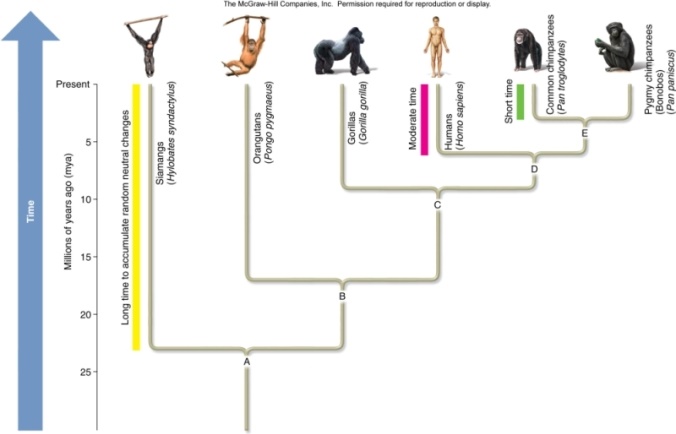
A)Siamangs and orangutans.
B)All of the species except orangutans.
C)All of the species except siamangs.
D)All of the species except siamangs and pigmy chimps.
E)Gorillas,humans,and both types of chimps.

A)Siamangs and orangutans.
B)All of the species except orangutans.
C)All of the species except siamangs.
D)All of the species except siamangs and pigmy chimps.
E)Gorillas,humans,and both types of chimps.

Unlock Deck
Unlock for access to all 38 flashcards in this deck.
Unlock Deck
k this deck
25
A phylogenetic tree is a diagram that describes a phylogeny.A phylogeny is
A)the evolutionary history of a species or group of species.
B)the geographic distribution of populations in a species.
C)the generations of individuals in a population.
D)the distribution of species in a given area in time.
E)a list of character traits of individual species set in a tree diagram.
A)the evolutionary history of a species or group of species.
B)the geographic distribution of populations in a species.
C)the generations of individuals in a population.
D)the distribution of species in a given area in time.
E)a list of character traits of individual species set in a tree diagram.

Unlock Deck
Unlock for access to all 38 flashcards in this deck.
Unlock Deck
k this deck
26
Consider the following cladogram and list of characteristics: 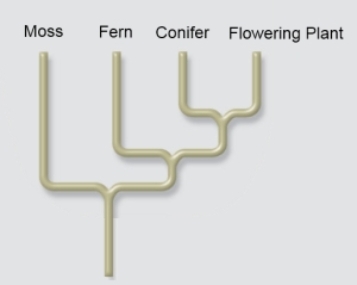
Based on what you know about the principle of parsimony,which of the following is most likely a shared derived character of conifers and flowering plants?
A)Chlorophylls a & b.
B)Vascular tissue.
C)Seeds.
D)Flowers.
E)Both seeds and flowers.

Based on what you know about the principle of parsimony,which of the following is most likely a shared derived character of conifers and flowering plants?
A)Chlorophylls a & b.
B)Vascular tissue.
C)Seeds.
D)Flowers.
E)Both seeds and flowers.

Unlock Deck
Unlock for access to all 38 flashcards in this deck.
Unlock Deck
k this deck
27
What kind of molecular information is commonly used to study phylogeny among species that diverged from a common ancestor relatively long ago?
A)Whole genomes because they are easy to obtain.
B)Segments of cellular membrane proteins because the proteins,coded by DNA,are found in all living organisms.
C)The mitochondrial genome because it easily incurs neutral mutations.
D)Small ribosomal subunit (SSU)RNA because it is found in the genomes of all living organisms.
E)DNA sequences within introns because their sequences change rapidly over evolutionary timE.
A)Whole genomes because they are easy to obtain.
B)Segments of cellular membrane proteins because the proteins,coded by DNA,are found in all living organisms.
C)The mitochondrial genome because it easily incurs neutral mutations.
D)Small ribosomal subunit (SSU)RNA because it is found in the genomes of all living organisms.
E)DNA sequences within introns because their sequences change rapidly over evolutionary timE.

Unlock Deck
Unlock for access to all 38 flashcards in this deck.
Unlock Deck
k this deck
28
The firefly (Photinus granulatus)and the zebra mussel (Dreissena polymorpha)are both members of the kingdom Animalia.This indicates that they must also both be members of the same
A)species
B)genus
C)order
D)phylum
E)domain
A)species
B)genus
C)order
D)phylum
E)domain

Unlock Deck
Unlock for access to all 38 flashcards in this deck.
Unlock Deck
k this deck
29
If the genus Quercus (oaks)is monophyletic,then this means that all species of oaks
A)grow in similar habitats.
B)are morphologically very similar.
C)are descended from a common ancestor.
D)cannot be classified in a single family or order.
E)have undergone horizontal gene transfer sometime in their evolutionary history.
A)grow in similar habitats.
B)are morphologically very similar.
C)are descended from a common ancestor.
D)cannot be classified in a single family or order.
E)have undergone horizontal gene transfer sometime in their evolutionary history.

Unlock Deck
Unlock for access to all 38 flashcards in this deck.
Unlock Deck
k this deck
30
Molecular clocks are based primarily on rates of
A)neutral mutations.
B)favorable mutations.
C)detrimental mutations.
D)natural selection.
E)horizontal gene transfer.
A)neutral mutations.
B)favorable mutations.
C)detrimental mutations.
D)natural selection.
E)horizontal gene transfer.

Unlock Deck
Unlock for access to all 38 flashcards in this deck.
Unlock Deck
k this deck
31
Members of the plant family Cactaceae (cacti)are native to the Americas and thrive in dry environments.They have a number of specialized adaptations,including reduced leaves,succulent (fleshy)stems for water storage,and spines for defense against herbivores.Some members of the family Euphorbiaceae are native to Africa and resemble cacti,having similarly reduced leaves,succulent stems,and thorns.However,their common ancestor likely did not have these traits.Based on this information,what can you say about the morphological traits of Cactaceae and Euphorbiaceae indicated above?
A)They are shared primitive traits.
B)They are shared derived traits.
C)They are homologous traits.
D)They are analogous traits.
A)They are shared primitive traits.
B)They are shared derived traits.
C)They are homologous traits.
D)They are analogous traits.

Unlock Deck
Unlock for access to all 38 flashcards in this deck.
Unlock Deck
k this deck
32
Horizontal gene transfer is the transfer of genes between
A)two chromosomes in a nucleus.
B)organelles within a cell.
C)cells within a multicellular organism.
D)different species,both prokaryotic or eukaryotic.
E)prokaryotic species to different prokaryotic species.
A)two chromosomes in a nucleus.
B)organelles within a cell.
C)cells within a multicellular organism.
D)different species,both prokaryotic or eukaryotic.
E)prokaryotic species to different prokaryotic species.

Unlock Deck
Unlock for access to all 38 flashcards in this deck.
Unlock Deck
k this deck
33
Horizontal gene transfer is less prevalent in eukaryotic species because
A)of the presence of organelles in the cells of eukaryotic species.
B)of the multicellularity in eukaryotic species,which is lacking in prokaryotic species.
C)eukaryotic species reproduce by sexual reproduction.
D)of multicellularity and sexual reproduction.
E)of the presence of organelles and multicellularity.
A)of the presence of organelles in the cells of eukaryotic species.
B)of the multicellularity in eukaryotic species,which is lacking in prokaryotic species.
C)eukaryotic species reproduce by sexual reproduction.
D)of multicellularity and sexual reproduction.
E)of the presence of organelles and multicellularity.

Unlock Deck
Unlock for access to all 38 flashcards in this deck.
Unlock Deck
k this deck
34
When comparing the sequences of a homologous gene in four different species,one pair of species shows a 1% difference,whereas the other pair shows a 3% difference.Which pair diverged longer ago from their common ancestor and why?
A)The pair with a 1% difference;a smaller difference (1% instead of 3%)indicates that there has been less time to accumulate mutations.
B)The pair with a 1% difference;a smaller difference (1% instead of 3%)indicates that there has been more time to accumulate mutations.
C)The pair with a 3% difference;A larger difference (3% instead of 1%)indicates that there has been less time to accumulate mutations.
D)The pair with a 3% difference;A larger difference (3% instead of 1%)indicates that there has been more time to accumulate mutations.
A)The pair with a 1% difference;a smaller difference (1% instead of 3%)indicates that there has been less time to accumulate mutations.
B)The pair with a 1% difference;a smaller difference (1% instead of 3%)indicates that there has been more time to accumulate mutations.
C)The pair with a 3% difference;A larger difference (3% instead of 1%)indicates that there has been less time to accumulate mutations.
D)The pair with a 3% difference;A larger difference (3% instead of 1%)indicates that there has been more time to accumulate mutations.

Unlock Deck
Unlock for access to all 38 flashcards in this deck.
Unlock Deck
k this deck
35
Consider the following cladogram and list of characteristics: 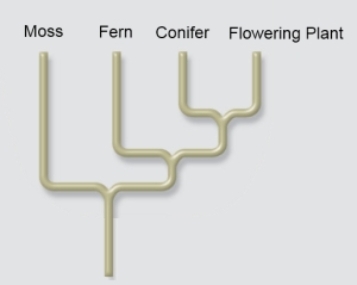
Based on what you know about the principle of parsimony,which of the following is most likely a shared primitive character of mosses,ferns,conifers,and flowering plants?
A)Chlorophylls a & b.
B)Vascular tissue.
C)Seeds.
D)Flowers.
E)Both chlorophylls a and b and seeds.

Based on what you know about the principle of parsimony,which of the following is most likely a shared primitive character of mosses,ferns,conifers,and flowering plants?
A)Chlorophylls a & b.
B)Vascular tissue.
C)Seeds.
D)Flowers.
E)Both chlorophylls a and b and seeds.

Unlock Deck
Unlock for access to all 38 flashcards in this deck.
Unlock Deck
k this deck
36
Molecular clocks are usually calibrated based on
A)guesses about the rates of mutations in a particular gene.
B)observed rates of mutation in a particular gene.
C)the first shared common ancestor for species known from the fossil record.
D)comparing the gene to similar genes in other kingdoms.
E)the date when two species diverged from a common ancestor.
A)guesses about the rates of mutations in a particular gene.
B)observed rates of mutation in a particular gene.
C)the first shared common ancestor for species known from the fossil record.
D)comparing the gene to similar genes in other kingdoms.
E)the date when two species diverged from a common ancestor.

Unlock Deck
Unlock for access to all 38 flashcards in this deck.
Unlock Deck
k this deck
37
A modern goal of systematics is to classify organisms based on similarity of form and function,regardless of their evolutionary relationships.

Unlock Deck
Unlock for access to all 38 flashcards in this deck.
Unlock Deck
k this deck
38
The mitochondrial genome would be most useful for studying evolutionary relationships among which group of organisms?
A)whales (members of the order Cetacea)
B)animals (members of the kingdom Animalia)
C)plants (members of the kingdom Plantae)
D)eukaryotes (members of the domain Eukarya)
E)all organisms (members of domains Bacteria,Archaea,and Eukarya)
A)whales (members of the order Cetacea)
B)animals (members of the kingdom Animalia)
C)plants (members of the kingdom Plantae)
D)eukaryotes (members of the domain Eukarya)
E)all organisms (members of domains Bacteria,Archaea,and Eukarya)

Unlock Deck
Unlock for access to all 38 flashcards in this deck.
Unlock Deck
k this deck



